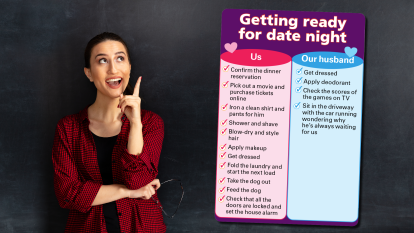4 Visualization Techniques to Soothe Stress and Embrace Positivity

You finally find a moment to relax, but worries keep replaying in your mind like a horror film on a loop. To the rescue: New research has found that we have the ability to escape any mental stress spiral simply by visualizing certain imagery, which dissolves anxiety in as little as 30 seconds. And positive visualization techniques don’t just reduce anxiety in the moment, they also retrain our brain to dislodge decades worth of self-doubt, spur us to achieve goals and enhance our physical well-being.
“When we imagine a peaceful scene or a desired outcome, the stress response gets dialed down, while brain regions we need to plan ahead see increased activity, reinforcing new neural pathways,” reveals neuroscientist Tara Swart, MD, PhD, senior lecturer at MIT Sloan and author of The Source (Buy on Amazon, $15.99). “The most effective visualizations have four key components: physical, mental, emotional, and spiritual — a scene that engages them all ‘rewires’ the brain in amazing ways.”
In fact, your imagination is so powerful, it can make you physically stronger. “In one study, a group was asked to lift weights while a second group simply pictured doing so,” says Dr. Swart. “Astonishingly, those who just imagined lifting weights saw 13 percent muscle growth.” Here, are four easy visualization techniques that turn stress into bliss, doubt into confidence and the blues into joy. The best part? Just reading about them can trigger these mind-body benefits!
Self-Critical? Imagine Caring For Yourself
After becoming the caretaker for your elderly father, you accidentally miss one of his doctor’s appointments. The guilt turbocharges your inner critic, and suddenly, you find yourself ruminating on all the balls you’ve dropped.
To escape this critical path, imagine the sensation of self compassion. “You have to feel visualizations in your body and associate them with a reward,” says Rick Hanson, PhD, author of Resilient (Buy on Amazon, $14.92), who suggests picturing a typical weeknight: It’s 6 pm. You see dishes in the sink, but rather than taking on another chore, picture rewarding yourself with a cup of tea. Relax your muscles and imagine tension melting away. The specificity of this scenario helps your brain believe it. “Another key to visualizing self-compassion is anticipating roadblocks and pre-solving them,” he says. “Envision what you’ll do if you start shaming yourself-maybe that looks like taking a few deep breaths. This helps you believe that you’re already kind to yourself, making it easier to show yourself compassion.”
Overwhelmed? Visualize a Hot-Air Ballon
With the stress of the past year, your emotions have been all over the place — and you’re not alone. More than half of us are struggling with a deluge of feelings like grief, anxiety, and envy, making us feel exhausted and fearful of the future.
To release negative emotions, envision a hot-air balloon in a field, says Dr. Swart. It’s held down by four sandbags, each labeled with a different emotion. The first bag, in red, says anger. Climb the ladder and release it. See the second bag in green, marked envy, and let it go. Do the same with the third in black: anxiety. “As for the fourth bag-that’s yours to discover,” she says. A word people often see? Expectations. If you struggle with perfectionism, let it go and take flight. “The more history we have with an emotion, the stronger the mental pathway — that’s why we want to keep disrupting it as much as possible.” In other words, keep releasing stress so that you can rise above it.
Lonely? Conjure Your “Caring Committee”
You’ve become an ace at virtual meetups, but the accrued effect of having to miss out on so many real-life get togethers is catching up with you. Before you know it, feeling lonely leads to feeling “less than” as you yearn for the support that used to buoy you up.
Just visualizing loved ones can help you see your inner strength. “Imagine sitting with six people who love you, or your ‘caring committee,’ and let them explain to you why you’re worthy of love,” urges Hanson. “Opening up to what they would say, lets you see your own innate wisdom.” Your caring committee, in other words, represents parts of yourself that you may have taken for granted. “You know what it feels like when something is true, like the fact that you love your daughter or that toast is better with butter,” says Hanson. “To bring that level of belief to your visualization, let yourself enjoy how rewarding it feels. A lot of us live in an invisible cage of self-doubt and loneliness, but just seeing how rich your connections are, helps you break free.”
Feeling Insecure? Picture Five Portals
After a setback at work, your confidence wanes. Soon, your insecurities seep into your personal life, until you question everything from how you look to if you’ll ever achieve your goals. When we feel defeated in one area of our lives, our entire sense of self often takes a hit, says Dr. Swart.
To see yourself succeed, imagine being on top of a mountain, says Dr. Swart. Carved into the side are 12 stone steps leading to a door. You open it to find five full-length mirrors. In the first, you’re in your underwear, comfortable in your skin. After you’ve drunk in that image, move on to the second mirror, where you’re in sports clothes, strong and confident. In the third mirror, you’re at the pinnacle of success. “Whatever you’ve wanted to achieve, you’ve met it,” says Dr. Swart. In the fourth mirror, you’re at a social event and everyone is happy to see you. Now walk to the fifth mirror. “A combination of the other four, it’s a portal-when you step into it, you’re stepping into your highest self,” she says. “Seeing yourself in this light releases feel-good dopamine, spurring you to go after your dreams.” After all, the mirrors reflect how multifaceted you are and how much you have to offer.
A version of this article originally appeared in our print magazine, First for Women.













